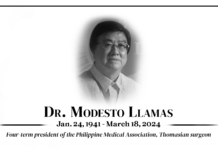A THOMASIAN researcher pitched a sensing method that could be used to rapidly detect and diagnose genetic diseases such as cancer in this year’s Panayam Pang-agham held on Nov. 27.
Lorico Lapitan Jr., an engineer teaching in the UST Department of Engineering, discussed how multivalent magnetic nanoparticles (MNPs) can help in the rapid detection of cancer.
In his study titled “Combining Magnetic Nanoparticle and Poly-enzyme Nanobead Amplification for Ultrasensitive Detection and Discrimination of DNA Single Nucleotide Polymorphisms,” Lapitan explained how combining magnetic nanoparticles, biomolecule and small molecules and bioconjugation chemistry can create MNPs.
Lapitan said MNPs could be used to destroy cancer cells through hyperthermia or exposure to increased heat or for drug delivery to tumors.
“Maaaring gamitin ang mga multivalent magnetic nanoparticles (MNPs) upang sirain ang mga selula ng kanser sa pamamagitan ng hyperthermia o gamitin ang mga magnetikong nanoparticle para kargahan at ihatid ang mga gamot sa mga tumor,” Lapitan, a researcher from the UST Research Center for the Natural and Applied Sciences, said.
MNPs can also be used to create sensors for early disease detection and imaging procedures such as magnetic resonance imaging.
Through early disease diagnosis, diseases such as cancer could be treated early, Lapitan said.
“Ang maagang pagsusuri o deteksiyon ay napakahalaga upang makita agad ang simula ng sakit. Mahalaga ito upang mapigilan ang lalong pagkalat ng mga sakit at mapabuti ang kalidad ng buhay ng tao,” he explained.
Asst. Prof. Nikki Dagamac also presented his study on slime molds and their distribution and evolution in the ecosystem through the years.
“Isa sa mga maituturing na ‘di pangkaraniwang organismo ang slime molds, ito ay may isang komplikadong siklo ng buhay — isang hayop at amag,” he said.
These organisms can also learn and adapt to different environments, like human beings.
Dagamac said the country has rich biodiversity but lacked biodiversity studies.
“Ito po yung nais kong ipagpatuloy na gawin sa mga susunod na taon dahil ako ay lubos na naniniwala na ang ating bansa ay [hitik sa] likas na yaman na siyang maituturing nating malaking handog sa buong mundo,” he added.
Panayam Pang-agham is a yearly event of the University’s Department of Filipino and the College of Science.
Its purpose is to promote the use of the Filipino language in technical discourse. C.D.A. Contreras














